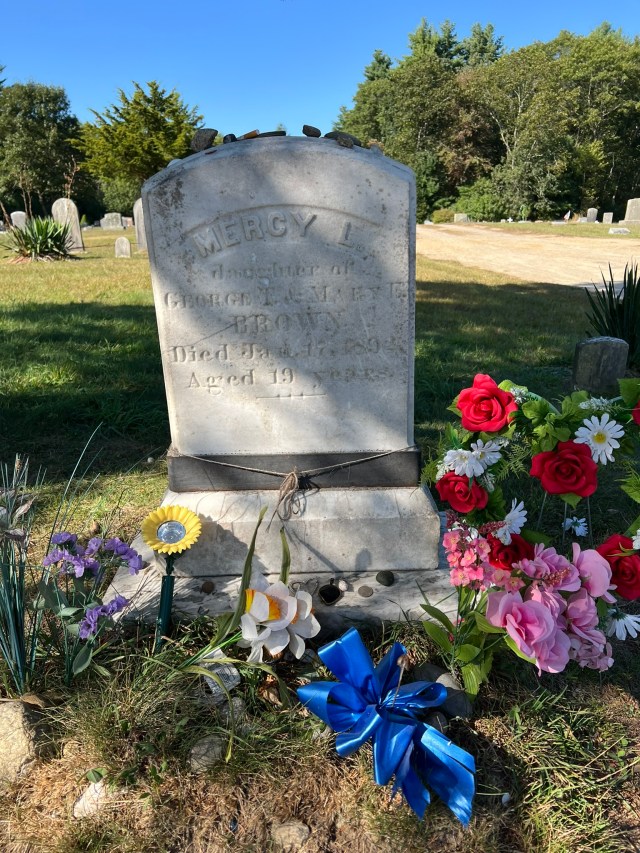Judging by her tombstone, underneath an evergreen tree in a sun-dappled historic cemetery, there’s nothing at all amiss about the final resting place of Mercy Brown. “Mercy L,” the stone reads, “Daughter of George L. and Mary E. Brown. Died Jan. 17, 1892. Aged 19 years.”
For an old grave in the small town of Exeter, R.I., it gets a lot of attention, the kind usually reserved for notable or historic figures. On any given day, a visitor could easily find several bouquets of flowers and small gifts, and rocks placed on top of the headstone.
But upon closer inspection, the stone does have an unusual feature. A metal band secures it to the ground, ensuring no one with larcenous intent can steal it away. Mercy Brown might not be a celebrity, but she lives on in history as Rhode Island’s most infamous “real” vampire.
As far as moral panics go (and this being New England, we have a lot of them), the vampire craze that swept Rhode Island in the late 1800s was relatively minor. Unlike the Salem witch trials, which saw 25 people executed or dead from harsh prison conditions, the fervor focused on people who had already died and were suspected of siphoning the vitality of their living relatives from beyond the grave.
The idea was borne from desperation. Tuberculosis (then referred to as consumption) was killing a huge portion of the population, and there was no reliably effective treatment or medicinal remedy. People resorted to the “vampirism” cure, a folk remedy that “required exhuming the bodies of deceased relatives and checking them for ‘unnatural’ signs, such as ‘fresh’ blood in the heart,” Michael Bell wrote in “Food for the Dead: On the Trail of New England’s Vampires.”
“The implicit belief was that one of the relatives was not completely dead and was maintaining some semblance of a life by draining the vital force from living relatives,” Bell explained. By ingesting the parts of the departed that still appeared to be alive, the living hoped to reclaim their lost health.
In a way, it makes sense. If someone is dying from a disease called consumption, a logical question to ask is exactly who – or what – is consuming them?

The Brown family had already faced devastating losses from consumption – the deaths of mother Mary Eliza and eldest daughter Mary Olive in the mid-1880s – when siblings Edwin and Mercy fell ill with the disease in 1891. Edwin went to Colorado for treatment and recovered, but Mercy died at home and was buried in the family plot in Chestnut Hill Cemetery off Ten Rod Road (which visitors can still easily see today). When he returned home, Edwin once again fell ill. In a last attempt to save his life, father George Brown allowed a group, including the local doctor, to exhume the bodies of his deceased loved ones in March 1892 under the suspicion that one was a vampire draining Edwin’s life force.
Mary Eliza and Mary Olive were appropriately decomposed, but Mercy’s body showed little decay, and she still had blood in her heart. (Details are hazy on this. Reports say she was exhumed, but since she died when the ground was frozen, it’s more likely her body would have been stored in the cemetery’s crypt until the spring thaw. The cold winter weather, and her above-ground storage, could easily explain the state of her corpse.)
There were many ways of “fighting” the vampirism suspected of making families ill, some of which revolved around the heart of the deceased person. Some people would exhume the dead relative and burn their heart, either inhaling the smoke, or eating the ashes.
That’s what happened to Mercy. When the locals saw that she seemed unnaturally vital, they cut out her heart, burned it and created a tonic with the ashes. Edwin drank it, but he still died two months later.
Even at the time, Mercy’s posthumous treatment was a scandal. An 1892 article in the Providence Journal, which Bell included in his book, said that locals were “testing a horrible superstition” when they exhumed her remains. “Bodies of dead relatives taken from their graves,” it continued, “they had all died of consumption, and the belief was that live flesh and blood would be found that fed upon the bodies of the living.”
Mercy is far from the only person suspected of being a vampire in Rhode Island, or who got caught up in the frenzy. Simon Whipple Aldrich, who died in 1841 in North Smithfield, is memorialized on his gravestone with an inscription mentioning “consumption’s vampire grasp.” But according to Bell’s book, Mercy is likely the last person exhumed under that suspicion in America.
Mercy’s memory and her legend live on. H.P Lovecraft wrote about her in “The Shunned House,” and Smithsonian Magazine suggested that even Bram Stoker knew her story and referenced it while writing “Dracula,” which debuted in 1897. In modern media, she’s been featured on the podcast “Lore” and its Amazon Prime show of the same name, and in many songs and novels.
Have you ever heard of the Mercy Brown vampire incident? Tell us in the comments.
Featured image: Chestnut Hill Cemetery
One Thought on “The Story of Rhode Island’s ‘Real’ Vampire, Mercy Brown”
Leave A Comment
Comments are subject to moderation and may or may not be published at the editor’s discretion. Only comments that are relevant to the article and add value to the Your AAA community will be considered. Comments may be edited for clarity and length.













we have a summer home in Exeter, R. I. for many years now and have visited Mercy Brown’s grave many times. When we bring people there, we make sure to have them read Mercy’s account from the book Haunted Rhode Island. She and her family are buried one after the other at the gravesite. We have always believed she was held until the Spring thaw in the “Keep” which is a stone crypt, a minutes walk from her gravesite. The Keep is still an eerie chamber to be seen.